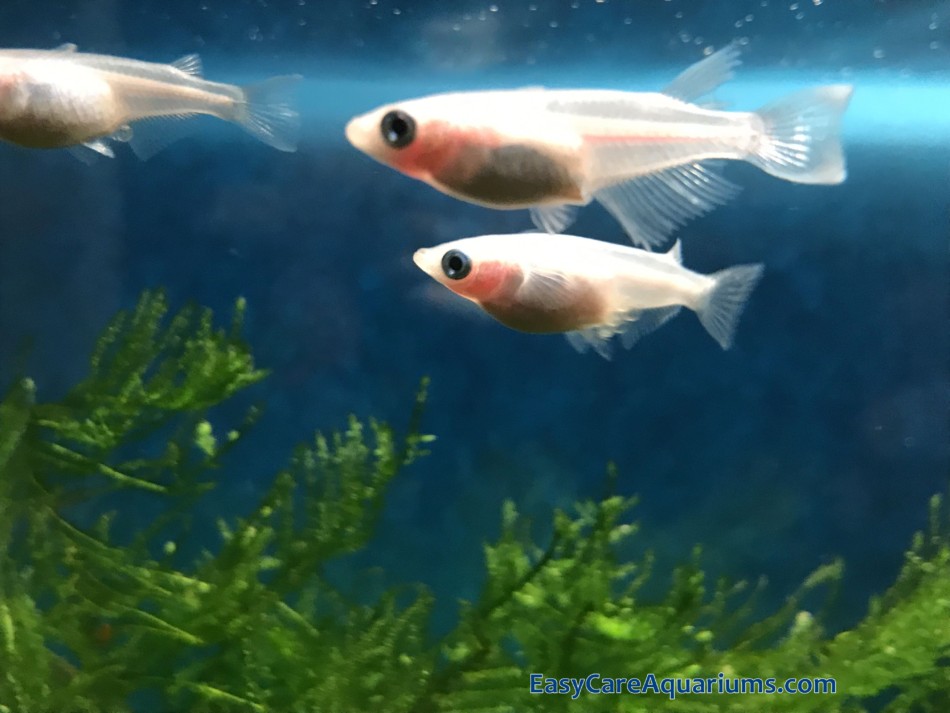This article may contain some affiliate links to products. The links provide me a small percentage of commission but do not cost you anything extra to use. (See full disclosure statement here ).
).
Ricefish are considered fairly easy to breed in the home aquarium. As long as you have both males and females in your tank, and the conditions are right, you’re likely to find that the population increases.
Ricefish are egg depositors. Which means that the eggs are fertilized internally during mating before being deposited amongst the plants. If no plants are available the female will deposit the eggs on other suitable surfaces, such as a spawning mop. The fertilized eggs will then go on to develop into Ricefish fry.
In an aquarium environment Ricefish tend to breed regularly. Although this can depend on the water temperature and the tank conditions.
Whether you intend to breed your Ricefish, or you’re just happy to wait and see what happens, knowing what to look out for is a great help.
Let’s start with the basics and then work our way through the detail.
How Can I Tell A Male Ricefish From A Female?
The first thing you’re going to want to know when it comes to breeding Ricefish is whether you’ve got both males and females in your tank. I know this sounds like an obvious statement but believe me it’s not as simple as it sounds.
Telling the difference between a male and female Ricefish is no easy task. And Ricefish keepers often have different opinions on how best to tell the sexes apart.
Despite some differences in opinion there are a few guidelines that crop up frequently.
- Males are slightly smaller and more slender than the females
- Males may have a little more colouring than the females
- Male dorsal and anal fins are a bit longer and may have ‘rays’ making the fin look spikey
- Male anal fins are little bigger than the female’s
The main problem is that the differences are so small they’re not easy to spot. Even if you get the chance to see both an adult male and adult female side-by-side for a minute or two it’s still hard to spot the differences.
One solution is to ask your Pet Store or Aquatic Dealer to give you a combination of the sexes. But don’t be surprised if they struggle to sex them, or they get it wrong.
It really is that difficult to tell them apart, particularly when they are still young.
Another way to increase the chance of having both male and female Ricefish in your tank is to buy a decent sized group of them. Ricefish prefer to live in groups so it’s a good idea to have at least 6-8 anyway. It also means that you’ll stand a better chance of having both sexes.
I originally bought 6 Ricefish which all looked identical to me. But within a couple of weeks 2 of them were carrying eggs. So I knew that I’d definitely got at least 2 females. Then a third one was carrying eggs too. Unfortunately one of the fish died but it wasn’t an ‘egg carrier’ and was smaller and slimmer than the ones that did have the eggs. Whether he was a male, or just one that hadn’t developed properly, I’ll never know. But I was sad to lose him nonetheless.
How Old Are Ricefish When They Start Breeding?
As I understand it Ricefish are considered to breed at an early age. Which means that they can start to breed at around 3 months old, although they may not start breeding until they are a little older than that. Having an adequate supply of good quality food and good tank conditions, will make a difference when it comes to the timing of breeding activity in the home aquarium. A healthy diet and a well maintained planted environment both go a long way in encouraging your Ricefish to breed.
For more information about what to feed your Ricefish and their fry read my article ‘What Do Ricefish Eat?’
What Does Ricefish Breeding Behaviour Look Like?
Ricefish breeding behaviour is fascinating to watch. The male swims underneath the female and will also swim in front of her in a circular motion before swimming underneath again. When they are both ready, and if the female has accepted the male, the male Ricefish goes alongside the female and holds her close using his dorsal and anal fins. The pair both wriggle as the gametes (sperm) are passed from the male to the female via the urogenital pores. The fertilized eggs are then released and held by the female’s anal fins until she is ready to deposit them onto the plants.
I’ve never seen this full mating display with my own Ricefish. But I have seen the initial mating ritual and I’ve also seen the female deposit eggs on the plants on several occasions. It’s just the actual fertilization part that I’ve missed out on.
Fortunately, I found an amazing YouTube video by Hideaki Takeuchi that shows the Ricefish mating ritual from start to finish. I’ve added the YouTube link below.
How Do Ricefish Deposit Their Eggs?
The female Ricefish will carry the eggs for some time before she is ready to deposit them. I’ve seen mine carry them for a day or more before deciding it’s time to place them amongst the plants. But once she’s ready the female will go amongst the plants and deposit the eggs, usually one at a time, on the plant leaves.
After the eggs are deposited neither the female or the male show any parental responsibility for them. The eggs are just left there while the adults carry on with their normal activity.
How Do You Identify Ricefish Eggs?
Ricefish eggs look like tiny transparent balls that are approx. 1 mm or less in diameter. The eggs often have a slight gold tint but this may depend on the tank lighting. Despite their small size the eggs are usually easy to spot amongst the plant leaves or on a dark coloured spawning mop.
How Many Eggs Do Ricefish Deposit At A Time?
Ricefish can produce up to 20 eggs at a time from each mating session. Although from personal experience, and the experiences of other Ricefish keepers, the number is generally lower than this. Anywhere between a single egg and 10 seems to be more usual.
How Long Do Ricefish Eggs Take To Hatch?
The average hatching time for Ricefish eggs is between 10-14 days. The hatch time will depend on water quality and water temperature. The eggs tend to hatch a little faster if the water is around 20 Degrees Celsius (68 Fahrenheit) rather than at the colder end of the Ricefish tolerance scale. So a moderate water temperature will make a difference.
How Often Do Ricefish Breed?
In the aquarium Ricefish will breed almost continuously if the tank conditions, food supply and the lighting hours are good. Regular partial water changes also help to encourage breeding. You can expect to see almost daily egg deposits over a period of several weeks/months. However, Ricefish do take a break from reproducing from time to time. Which means that they may stop their breeding activity for several weeks before beginning again.
In their native habitat Ricefish breed between April and October when the water temperature is a little warmer and there are more hours of daylight. If you replicate these conditions in your Ricefish tank they will continue to breed despite taking a little time out now and again.

Do Ricefish Eat Their Eggs And Fry?
The Ricefish is not considered predatory when it comes eating to their own eggs. Although it does happen and I’ve experienced this myself. Eating their own fry though is more of a common thing. Plus older fry from earlier batches are prone to eating their younger siblings. Because Ricefish are not parental to either their eggs or fry it means that you can lose a fair amount of baby Ricefish this way. So if you want to save as many Ricefish fry as possible you need to take steps to protect them from their parents and any other tank inhabitants.
How Do You Save Ricefish Eggs And Fry?
The best way to save as many Ricefish eggs and fry as possible is probably to set up a separate cycled breeding tank. Once the female Ricefish has deposited her fertilized eggs on the plants, or spawning mop, the adults should be moved back into the main tank. By removing the adults you’ll be protecting the eggs, and future fry, from being eaten. Once the fry are too big to be eaten by their parents, siblings and/or tankmates you can put them back into the main tank.
But what if you don’t have, or don’t want to set up a separate breeding tank?
Another option is to have plenty of plants in your tank for the eggs to be deposited on and for the fry to hide in. Providing lots of dense plant leaves helps to hide the eggs from other fish. Also a densely planted aquarium creates lots of hiding spaces for young fish until they are big enough to venture out into the main areas of the tank.
So if you’re happy to just let nature take it’s course this might be the solution for you.
Why Do Ricefish Eggs Often Fungus?
It’s not uncommon for Ricefish eggs to fungus, fail to develop, or just go off. It can be difficult to get to the bottom of the problem but here’s a few reasons why Ricefish eggs often don’t produce living fry.
- Fungus – naturally occurring fungi in an aquarium can infect unfertilized eggs which can then spread to the fertilized eggs causing them to decay. Eggs that have fungus tend to look fluffy and won’t produce any fry.
- Unfertilized Eggs – there’s no guarantee that all the eggs that are deposited have been fertilized during mating. Any unfertilized eggs will mould over time. These eggs tend to turn creamy in colour and gradually rot away if they’re not removed from the tank.
- All Female Tank – female Ricefish often produce and deposit eggs even when there are no male Ricefish in the aquarium. These eggs are not viable so will decay.
- Poor Tank Conditions – Ricefish eggs, just like their parents, do best in well maintained tank conditions. So if you want your Ricefish to breed successfully it’s important to keep on top of your regular tank maintenance. Tank temperature is important too. Breeding is generally more successful if the water temperature is around 20 Degrees Celsius (68 Fahrenheit).
Even if you’ve experienced problems with eggs that won’t hatch don’t despair. Your Ricefish will keep trying to reproduce and you should find that at some point there a tiny fry swimming around the tank.

